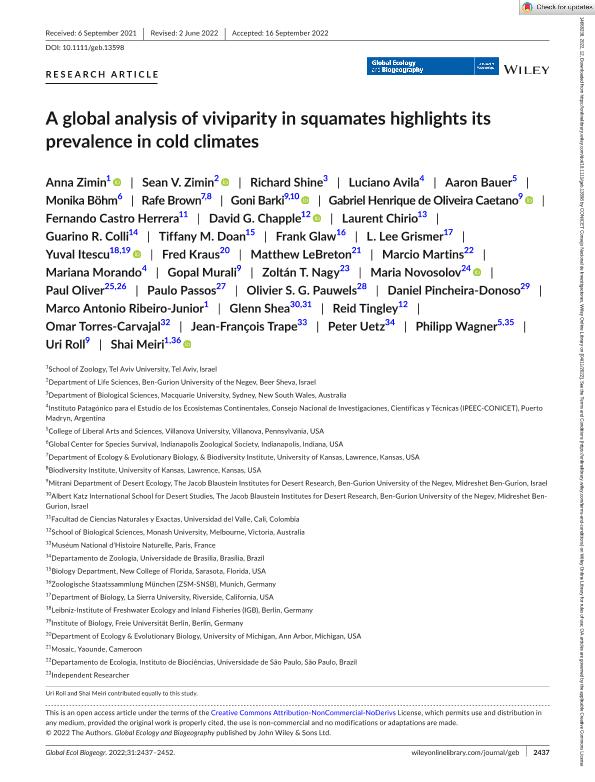Artículo
A global analysis of viviparity in squamates highlights its prevalence in cold climates
Zimin, Anna; Zimin, Sean V.; Shine, Richard; Avila, Luciano Javier ; Bauer, Aaron; Böhm, Monika; Brown, Rafe; Barki, Goni; de Oliveira Caetano, Gabriel Henrique; Castro Herrera, Fernando; Chapple, David G.; Chirio, Laurent; Colli, Guarino Rinaldi; Doan, Tiffany M.; Glaw, Frank; Grismer, L. Lee; Itescu, Yuval; Kraus, Fred; LeBreton, Matthew; Martins, Marcio; Morando, Mariana
; Bauer, Aaron; Böhm, Monika; Brown, Rafe; Barki, Goni; de Oliveira Caetano, Gabriel Henrique; Castro Herrera, Fernando; Chapple, David G.; Chirio, Laurent; Colli, Guarino Rinaldi; Doan, Tiffany M.; Glaw, Frank; Grismer, L. Lee; Itescu, Yuval; Kraus, Fred; LeBreton, Matthew; Martins, Marcio; Morando, Mariana ; Murali, Gopal; Nagy, Zoltán T.; Novosolov, Maria; Oliver, Paul; Passos, Paulo; Pauwels, Olivier S. G.; Pincheira-Donoso, Daniel; Ribeiro-Junior, Marco Antonio; Shea, Glenn; Tingley, Reid; Torres-Carvajal, Omar; Trape, Jean-François; Uetz, Peter; Wagner, Philipp; Roll, Uri; Meiri, Shai
; Murali, Gopal; Nagy, Zoltán T.; Novosolov, Maria; Oliver, Paul; Passos, Paulo; Pauwels, Olivier S. G.; Pincheira-Donoso, Daniel; Ribeiro-Junior, Marco Antonio; Shea, Glenn; Tingley, Reid; Torres-Carvajal, Omar; Trape, Jean-François; Uetz, Peter; Wagner, Philipp; Roll, Uri; Meiri, Shai
 ; Bauer, Aaron; Böhm, Monika; Brown, Rafe; Barki, Goni; de Oliveira Caetano, Gabriel Henrique; Castro Herrera, Fernando; Chapple, David G.; Chirio, Laurent; Colli, Guarino Rinaldi; Doan, Tiffany M.; Glaw, Frank; Grismer, L. Lee; Itescu, Yuval; Kraus, Fred; LeBreton, Matthew; Martins, Marcio; Morando, Mariana
; Bauer, Aaron; Böhm, Monika; Brown, Rafe; Barki, Goni; de Oliveira Caetano, Gabriel Henrique; Castro Herrera, Fernando; Chapple, David G.; Chirio, Laurent; Colli, Guarino Rinaldi; Doan, Tiffany M.; Glaw, Frank; Grismer, L. Lee; Itescu, Yuval; Kraus, Fred; LeBreton, Matthew; Martins, Marcio; Morando, Mariana ; Murali, Gopal; Nagy, Zoltán T.; Novosolov, Maria; Oliver, Paul; Passos, Paulo; Pauwels, Olivier S. G.; Pincheira-Donoso, Daniel; Ribeiro-Junior, Marco Antonio; Shea, Glenn; Tingley, Reid; Torres-Carvajal, Omar; Trape, Jean-François; Uetz, Peter; Wagner, Philipp; Roll, Uri; Meiri, Shai
; Murali, Gopal; Nagy, Zoltán T.; Novosolov, Maria; Oliver, Paul; Passos, Paulo; Pauwels, Olivier S. G.; Pincheira-Donoso, Daniel; Ribeiro-Junior, Marco Antonio; Shea, Glenn; Tingley, Reid; Torres-Carvajal, Omar; Trape, Jean-François; Uetz, Peter; Wagner, Philipp; Roll, Uri; Meiri, Shai
Fecha de publicación:
10/2022
Editorial:
John Wiley & Sons Ltd
Revista:
Global Ecology and Biogeography
ISSN:
1466-822X
e-ISSN:
1466-8238
Idioma:
Inglés
Tipo de recurso:
Artículo publicado
Clasificación temática:
Resumen
Aim: Viviparity has evolved more times in squamates than in any other vertebrate group; therefore, squamates offer an excellent model system in which to study the patterns, drivers and implications of reproductive mode evolution. Based on current species distributions, we examined three selective forces hypothesized to drive the evolution of squamate viviparity (cold climate, variable climate and hypoxic conditions) and tested whether viviparity is associated with larger body size. Location: Global. Time period: Present day. Taxon: Squamata. Methods: We compiled a dataset of 9061 squamate species, including their distributions, elevation, climate, body mass and reproductive modes. We applied species-leveland assemblage-level approaches for predicting reproductive mode, both globally and within biogeographical realms. We tested the relationships of temperature, interannual and intra-annual climatic variation, elevation (as a proxy for hypoxic conditions) and body mass with reproductive mode, using path analyses to account for correlations among the environmental predictors. Results: Viviparity was strongly associated with cold climates at both species and assemblage levels, despite the prevalence of viviparity in some warm climates. Viviparity was not clearly correlated with climatic variability or elevation. The probability of being viviparous exhibited a weak positive correlation with body size. Conclusions: Although phylogenetic history is important, potentially explaining the occurrence of viviparous species in regions that are warm at present, current global squamate distribution is characterized by a higher relative abundance of viviparity in cold environments, supporting the prediction of the “cold-climate” hypothesis.The roles of climatic variation and hypoxia are less important and not straightforward. Elevation probably exerts various selective pressures and influences the prevalence of viviparity primarily through its effect on temperature rather than on oxygen concentration.
Archivos asociados
Licencia
Identificadores
Colecciones
Articulos(IPEEC)
Articulos de INSTITUTO PATAGONICO PARA EL ESTUDIO DE LOS ECOSISTEMAS CONTINENTALES
Articulos de INSTITUTO PATAGONICO PARA EL ESTUDIO DE LOS ECOSISTEMAS CONTINENTALES
Citación
Zimin, Anna; Zimin, Sean V.; Shine, Richard; Avila, Luciano Javier; Bauer, Aaron; et al.; A global analysis of viviparity in squamates highlights its prevalence in cold climates; John Wiley & Sons Ltd; Global Ecology and Biogeography; 2022; 10-2022; 2437-2452
Compartir
Altmétricas



